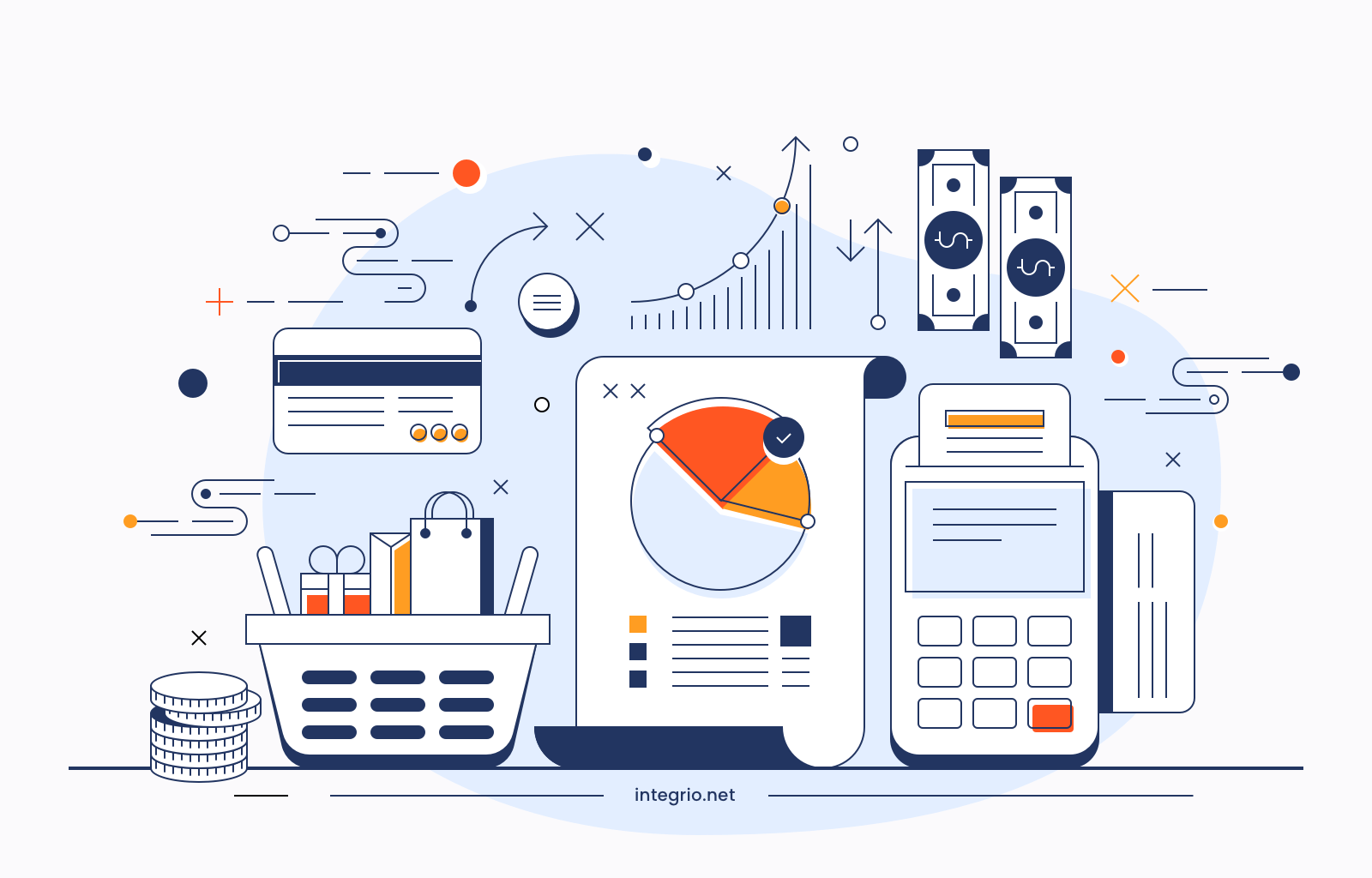How to Build a Custom Retail Assortment Management Application

Retailers increasingly leverage technologies to enhance inventory management and customer experiences. Industry trends also include a rising focus on omnichannel retailing. It increases demand for automated solutions, resulting in a boom for differentiated product offerings. All this encourages companies to consider developing custom retail assortment management software, which overcomes the challenges and brings numerous benefits to a business.
Do you also want to improve the customer experience, optimize processes, and be ready for unforeseen events? Then, it's time to discuss these and other advantages of retail assortment management software development, factors to consider, and crucial creation steps.
What is a Retail Assortment Management Application?
A retail assortment management application is a specialized software tool retailers use to plan, organize, and optimize the selection of products offered in their stores. The primary goal is to ensure that the product assortment aligns with market demands, enhances customer satisfaction, and maximizes return on inventory investment.
Intelligent retail solutions assist in managing merchandise from the planning stage to the point of sale. It involves assortment and item planning, process automation, inventory management, reporting, and analytics functionalities.
The Advantages of Using Custom Retail Assortment Management Application
Retailers now opt for custom software development to gain a competitive edge through unique solutions and process automation. Traditional planning methods involved manual tasks like spreadsheet use and hand-drawn display sketches, leading to errors and inefficiencies. Planning software addresses these challenges, offering a range of benefits:
Accurate Predictions
With merchandise planning, retailers can analyze and adapt to different scenarios based on market changes, economic shifts, or unexpected events. This way, you drill into financial plans, forecast results, and use real-time performance data to make informed adjustments. Retailers can also simulate various scenarios, assessing their potential impact on sales, profit margins, and inventory levels.
As a result, businesses quickly adapt to changing market conditions, capitalize on opportunities, and mitigate risks. Moreover, it ensures a proactive approach to business management.
Manual Effort Reduction
In the past, creating store display sketches and managing multiple inventories involved extensive manual labor. Teams had to keep track of detailed product information, use spreadsheets for planning, and handle many other tasks.
The retail assortment management software simplifies display design, inventory management, tracking, and payments. It makes them more efficient and less prone to mistakes. Specialized tools save time and enhance overall accuracy. Thus, teams focus on strategic decisions rather than repetitive manual tasks.
Detailed Business View
With merchandise management software, retailers gain a detailed understanding of various business processes. With its flexibility, users create plans from a thorough, bottom-up perspective and a broad, top-down approach. It ensures that plans are comprehensive and well-informed.
Such software enables businesses to adapt strategies based on a nuanced view of their operations. Retailers incorporate relevant information into the planning process to make more precise and effective decisions, leading to business growth and success.
Data Integrity
Merchandise planning software ensures the business's information is reliable and accurate. It is crucial for making informed decisions regarding inventory, sales forecasts, and retail strategies. Also, the software facilitates seamless integration with various data sources, like sales databases, supply chain systems, and market trends.
Moreover, the system can identify inconsistencies or duplications within datasets and standardize the information for consistency. Also, it often includes security measures to protect the integrity of sensitive data, preventing potential breaches and unauthorized access.
Customer Segmentation
Retail assortment management software leverages analytical tools to categorize customers based on preferences, purchasing behavior, and demographics. This way, you understand your diverse customer base more intimately. Tailor assortments to different customer segments' needs and preferences to enhance their shopping experience.
For example, if a specific segment prefers eco-friendly products or luxury items, the retailer can adjust assortments accordingly. A personalized approach improves customer satisfaction and fosters loyalty, as individuals feel a stronger connection to your store.
Space Optimization
Retailers can strategically allocate store space by analyzing factors like product demand, sales velocity, and promotional considerations. It ensures you display high-demand or promotional items permanently, maximizing visibility and potential sales.
Through intelligent space allocation, retailers create customer-friendly layouts that encourage exploration and facilitate easy navigation. As a result, you increase sales and customer satisfaction. Additionally, the applications assist in adapting the store layout to accommodate changing merchandising strategies or seasonal variations.
Factors that Impact Retail Assortment Management Software Development
Deciding to use merchandise planning software is highly beneficial for your business. However, one should do more than just pick the best development company. Consider several crucial factors:
Market Research
Conducting thorough market research lets your company stay abreast of the latest trends and demands within the target market. Analyzing customer interests and preferences provides valuable insights to shape your software features and functionalities. Also, pay attention to competitors, including their use of the latest technologies, industry trends, and frameworks.
Using these insights, benchmark your plans against industry standards and identify areas where you can introduce uniqueness to your services. Align your software development strategy with market needs to enhance the chances of creating a successful solution.
UX/UI Design
Good UI/UX design enhances user experience, boosts productivity, and improves data management. UI (user interface) encompasses elements like screens and buttons, directly impacting how users interact with the software and explore its features. UX (user experience) focuses on the user's overall journey with the software, making it intuitive and efficient.
For example, thanks to consistent color schemes, fonts, and layouts, users quickly recognize and interpret information. It promotes a seamless and result-driven planning process. Also, organize buttons and menus consistently. Thus, users will find what they need without unnecessary clicks. Consider the importance of UI/UX design when hiring a development team. It directly affects the software's usability and user satisfaction.
MVP Development
An MVP is a product version incorporating selected features and designs, allowing businesses to assess its appearance and functionality.
Here are the most compelling reasons to opt for MVP development:
You can test the initial features and designs, gather feedback, and make necessary adjustments without significant investments.
Developing an MVP accelerates the time-to-market for the software solution. Instead of waiting for the full product, businesses can introduce a basic version to the market sooner.
Creating an MVP reduces the risks of full-scale development as you test the concept in smaller sizes.
MVP allows for feature and design modifications based on early feedback. So you can be flexible in changing or improving your strategies.
Vendor Selection
When choosing the right vendor, you can create an effective retail assortment management application. Whether looking for an expert consultant or a full-fledged team to create a platform, consider the following points:
Look for proven expertise in custom retail software development. The team should deeply understand market trends, customer behaviors, and challenges in assortment planning.
Prioritize the latest technologies and tools relevant to retail assortment management. They include AI, analytics, and integration capabilities.
Establish a collaborative approach involving you in development and incorporating your insights and requirements.
Focus on software scalability and robust security practices. Protect sensitive retail data like customer information and inventory details.
Opt for post-launch support and maintenance services to address any issues promptly.
Choose transparent cost structures and alignment with your budget constraints.
Hire a vendor with clear and practical communication skills to foster a smooth collaboration and minimize misunderstandings.
How to Develop Custom Retail Assortment Management Software in 2024
Let's take a look at the essential steps required for retail assortment management software development:
1. Assess the Market and Your Customer
First, evaluate the target market thoroughly. Identify the latest market trends and technologies relevant to the services you plan to offer. Pay close attention to the most common tools in your industry. Additionally, assess customer behavior by understanding their demands and preferences.
2. Set Clear Project Objectives
This crucial phase involves communicating your requirements to the software development company. Utilize the data obtained from market research to gain insights into industry trends and customer demand. With a clear understanding of the market dynamics, formulate business goals and strategies to align with your objectives.
3. Partner with the Development Team
The next stage involves selecting a reputable enterprise software development company. We have already considered the criteria in the previous section. Note that cooperation with an outsourced vendor is much faster and cheaper than hiring an in-house team.
You don't have to worry about the workplace, equipment, sick leave, vacation, bonuses, and other aspects of running your team in-house. In addition, in outsourcing, an experienced project manager handles development and keeps you informed of the progress. In turn, you can engage in more critical strategic tasks.
4. Make Proper Planning
Work closely with the development team to outline the functionalities, user interface design, and system architecture. Establish clear milestones and timelines for project development. Effective communication and collaboration at this stage are crucial for aligning expectations and ensuring the process progresses smoothly. This collaborative effort sets the foundation for turning your vision into a tangible solution.
5. Design and Build the Product
UI and UX designers create an intuitive and visually appealing interface, ensuring a seamless user experience. Prototyping provides you with a visual representation of the software's structure.
Meanwhile, backend developers work on server-side logic and database functionality. Frontend specialists bring the design to life on the client side. Integration of features like assortment planning tools and inventory management also occurs at this stage.
6. Test and Deploy
Rigorous QA testing is crucial to identify and rectify potential issues in modules, integrations, and the entire system. User acceptance testing ensures real-world validation, allowing refinement and iteration based on feedback.
Deployment encompasses various tasks, including configuring servers, optimizing performance, and addressing final adjustments based on user testing feedback. A thorough deployment plan minimizes downtime and disruptions. Once deployed, ongoing monitoring and support are essential to address any unforeseen issues promptly.
Optimize Your Assortment Management with Integrio
Retail assortment management software development offers businesses advanced analytics and forecasting. It improves buying and stocking processes, increasing profitability. Such software will also help you identify trends, optimize inventory, and integrate with other retail systems. It provides a detailed view of the business and improves overall data management.
Integrio has over twenty years of experience building advanced software for enterprises and startups in various industries, including retail and e-commerce. Thanks to our top-notch skills and capabilities in AI and ML technologies, we create systems that distinguish you in the market and guarantee excellent business outcomes. Contact Integrio's dedicated developers to discuss your project needs.
Contact us

